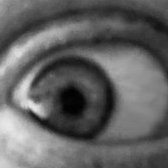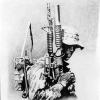Search the Community
Showing results for tags '1/4'.
-
For a complete change of pace, I decided to tackle Eduard’s BF 109E instrument panel in ¼ scale. I’m a big fan of Eduard and their precision is certainly Tier One in my book. My goal for this build was to work on my neatness and not rely on ageing to hide my clumsiness. This kit was no different – everything went together really well and the fact that it is ¼ scale meant that I spent much less time squinting through my magnifying headgear than normal! If I have to be critical in a constructive manner, I would suggest to Eduard that the details for attaching the PE handle arms to the plastic handles are poor and a re-think is needed. Eduard’s two PE handle arms have a minute (perhaps a millimeter long) nib that protrudes from the end of the PE. The seemingly solid plastic balls which are the handles have a correspondingly minute hole to receive this nib. You can see these circled joints on the instructions below which I found to be poorly engineered and very weak – no amount of finesse and skill on my part was going to make these joints work, so I needed to come up with another solution. My solution was to cut a trench halfway through the plastic balls, wedge the ends of the PE into the trenches and then “backfill” with CA. This gave the strong joint I needed. Getting the pretty sizable (and thus not insignificant in terms of mass) PE handles to adhere to the slot in the instrument panel was a big ask, given the tiny contact surface. My workaround was to temporarily glue a piece of clothes peg into the slot and next to it to give the handle something to rest against while the CA dried. If that had not worked, I was going to have to either cut through the bottom of the slot through to the back of the instrument panel piece and attach the end of the PE handle from the back with a bigger and stronger joint. As a last resort, I considered re-making the PE handles from styrene sheet, but fortunately didn’t need to. Eduard: something to think about, please. Paints were Tamiya’s XF-63 German Grey and Gunze H12 Flat Black, with other Gunze colours as accents. It was my first time using Mr Color Dark Iron (MC214) and it is amazing stuff when you give it a little polish after the paint dries – incredibly realistic. I made some mistakes and took a few liberties here and there, including omitting colour to some of the instrument bezels – I found lots of reference photos of real instrument panels with plenty of variety in term of colour on some bezels. Some panels looked a little like Christmas trees with bright yellow, blue and red, and others were very stark and monochromatic. I went for the latter. I needed some way to display this, so spent a couple of hours with a sheet of Evergreen 2mm thick styrene sheet and came up with a custom stand, sprayed black from a rattle can. As a final touch and to try and give this one a little personality, I found a period-correct family portrait and re-printed it as a 4" x 5" in ¼ scale, left it in my sweaty pocket for a few hours on a golf course (summer has arrived in the Middle East) and then tacked it to the instrument panel. These aircraft were flown by men from families so I thought it would be believable that one of those men might keep a picture of his family on his “desk” while at work... This is/was a limited run kit, so isn’t that easy to find. If you do come across one, I highly recommend it. Hope you enjoy the photos.
-
Bought this on eBay from a guy who had stored it away for a few years after buying it off someone who had cut the legs off and cut the lower torso up. Apparently the first owner had wanted to change the stance and given up, I've had this one on the go since February and it's been very slow going as it's the first time I've worked with vinyl and having to repair the damage wasn't the easiest thing I've ever had to do. I've done a stupid amount of research which has revealed errors in nearly every part of the figure which I've tried to address as best I can. It's about 80% done but one of the big things left to do is to build a Lightsaber from scratch. This is the photo from the eBay listing, I took a bit of a chance on it but I'm glad I did. It helped that I only paid just under £15 posted You can see where it had been cut, I really needed to be a model making octopus when I fitted it all back together! The moulded belt box details were awful so I started from scratch and turned a lot of the parts from acrylic rod. I bulked out the belt boxes with Milliput, the middle one should just be a belt buckle but there was no way of doing that with the way it was moulded. And this is where I'm at with it. I have both arms done and have reworked the right hand for a correctly sized lightsaber. (The glossy finish on the helmet is polished CA, lots of CA!)
-
To give myself a break form all the filling and sanding that my Italeri Hurricane is going to need I thought I'd start on my Eduard BF109 1/4 scale cockpit panel. Its going to be built straight from the box using Vallego and Tamiya acrylic paints. I intend to build it in parallel with my Hurricane so it could take a long time. Anyway first off a shot of the box. So far all I've done is made a start on the Revi gunsight (Tamiya Flat Black) and spray the two panels Vallego Model Air schwartzgrau (RLM66). The paint is still wet in the shots hence the slighty mottled effect, in real life they look ok. Well thats it for now. Yours aye Iain
-
Bf-110C Instrument Panel Eduard 1:4 This interesting subject of a kit arrives in a bright yellow and blue top opening box with a picture of the completed panel on the front. Inside there are two sprues of blue/grey styrene, the one piece panel itself, two sprues of clear styrene, two small sheets of pre-painted etched parts and a sheet of decals. The instructions, in a pleasing, colour printed A5 sized booklet are very clear and quite easy to follow which is a welcome change for Eduard. The only comment would be that it would have been nice to have the names of the individual instruments and controls included, which would have made this an informative/educational kit as well as being an interesting model. The parts are all very well moulded with some fine detail, no sign of flash and moulding pips only on the panel, which will need some cleaning up. The clear parts are very clear and well protected, each sprue being in separate poly bags. The pre-painted etch is very nice and can be used straight from the fret, with the exception of a couple of parts which will need to be bent to follow the curves of the underlying plastic parts. It may be advisable to paint the majority if not all the parts before starting the build, but the modeller will know what suits them best. The build starts with the construction of two switch boxes for the undercarriage and flaps, consisting of the backbox, two switches an etched guard for the undercarriage selector and etched nametags for the switches, the placards for the flaps and landing gear selectors should be reveresed as the instructions appear wrong. The mixture controls, which are made using a two piece control box, etched nameplate and control knob, which shouldn't be glued leaving it moveable. These are all then fitted to the main panel along with their associated etched nameplates and the undercarriage/flap indicator bezel and etched speed warning label. To the bottom left of the main panel the hydraulic pressure gauge made up of the indicator card, needle, glass, bezel and nameplate fitted with two screws, is attached. Beneath this are two selector buttons, one for the flap system pressure and one for the undercarriage system. On the top left corner of the centre panel there is a large red pull knob is fitted along with its associated etched nametag, whilst the wording is readable, I cannot find out what this is actually for, even using translation software. Next to this is the gun armed/un-armed panel is attached, having previously been painted, once fitted the decals can be added. To its right there is a gun selector switch, (either two or four guns), a pitch/roll trim gauge is made up using the card/needle/glass and bezel construction. Beneath this is a rudder trim gauge of card/glass/bezel and decal. Still on the centre panel to the left hand side the gyro compass instrument is fitted, this instrument has lower and upper etched cards, glass, bezel and center knob. To the left of the GC is the ammunition counter with simulated amounts of ammunition with the counter windows. To the far right of the centre panel is the VSI, (vertical speed indicator), again built up using the card/needle/glass and bezel arrangement. The rest of the centre panel consist of the standard up-side down T shape of aircraft instruments, consisting of, in order, Turn-and-bank indicator, altitude indicator, HSI, (Horizontal Situation Indicator), and ASI, (Air Speed Indicator), all built up as per the other instruments mentioned above. The bottom of the center panel is made up of two oil temp gauges, a central fuel gauge, with selector switches either side to select which tank the gauge is reading from, there are also three selector switches beneath the gauges which I presume are the left and right radiator flap controls and a central heating control, but again the translator didnât help much. Finally, the right hand section of the main panel is populated top to bottom with a stopwatch, two pressure gauges, two RPM gauges and lastly two oil pressure gauges, all constructed in the usual fashion of card decal/needle/glass and bezel with their associated nameplate/warning plates. Decals The decals for the instruments are beautifully printed, and of course, in this scale are very readable. They are nicely dense, opaque and in good register. Conclusion This is a great kit and is so different it would make for a useful model to keep the old mojo going during a downturn. Whilst not looking too difficult to build it will certainly benefit from some good painting and careful yet restrained weathering. Eduard are to be commended for releasing this as a separate kit, the like of which were only previously available in their Royal Class kits. Highly Recommended. Review sample courtesy of





